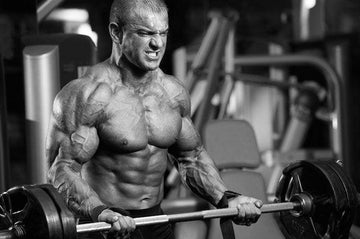

Cardio When Combined with Strength Training: Enhances Muscle Size
Table of Contents
Cardio When Combined with Strength Training: Enhances Muscle Size
by: Robbie Durand
For years there has been talk that doing both cardio and resistance exercise at the same time will halt your muscle growth gains. It has been previously thought by researchers that combining cardio and resistance exercise into a concurrent training program leads to suboptimal adaptations. For example, a previous research study found that the gains in lean muscle mass were less when combined resistance exercise and cardio were performed, whereas the group that did resistance exercise only gained greater strength and lean muscle mass1.
Does Combining Cardio and Resistance Exercise Kill Your Muscle Gains?
Many bodybuilders will do cardio only when they are trying to lose fat, some bodybuilders will skip cardio in the off-season to pack on extra seize. For example, a previous research study found that the gains in lean muscle mass were less when combined resistance exercise and cardio were performed, whereas the group that did resistance exercise only gained greater strength and lean muscle mass. Some researchers have proposed that the excessive volume of training when both aerobic exercise and resistance training are employed together causes this interference effect. The newest research seems to suggest that cardio has no impact on impacting muscle growth. For example, researchers had 42 males participate in the 24-week study. The participants performed either:
– supervised cardio, immediately followed by strength training, or
strength training, followed by cardio (two to three combined cardio and resistance sessions per week).
Before and after the trial, the researchers measured physical fitness and body composition. The aerobic exercise program involved a cycle ergometer, and the resistance-training program included exercises for all major muscle groups but had a focus on the lower body. The overall duration of the strength workout within each concurrent training session was 30–50 minutes, and the overall training session involving both endurance and strength training sessions was 60–100 minutes. At the end of 24-week training period, and both groups actually increased physical performance and muscle size to about a similar extent. 1RM strength, total lean mass, and muscle cross-sectional area increased similarly in both groups at Week 24 to a similar extent. Based on these findings, the training order of combined cardio and resistance training does not seem to have an effect on biological adaptations.
Does Performing Both Cardio and Weight Training Together Affect Myostatin?
The most recent study examined whether aerobic exercise combined with resistance exercise suppressed myostatin levels. This study compared the effects of concurrent training, strength training, and interval training on the muscle fiber cross-sectional area response, and on the expression of selected genes involved in the myostatin (MSTN) signaling mRNA levels. Thirty-seven physically active men were randomly divided into 4 groups: concurrent training, strength training, and interval training and control group and underwent an 8-week training period. Vastus lateralis biopsy muscle samples were obtained at baseline and 48 hours after the last training session. Muscle fiber CSA, selected genes expression, and maximum dynamic ST (1 repetition maximum) were evaluated before and after training. At the end of the study, myostatin genes levels remained unchanged across time and groups. These findings are suggestive that myostatin and their regulatory genes are not affected by concurrent aerobic and strength training, so it seems that doing cardio and strength training together is not going to impact changes in muscle mass.
 Cardio May Enhance Muscle Growth Responses to Resistance Exercise
Cardio May Enhance Muscle Growth Responses to Resistance Exercise
In a shocking paper published in PLOS ONE, may have bodybuilders rethinking the role of cardio and resistance exercise titled, “Endurance Exercise Enhances the Effect of Strength Training on Muscle Fiber Size and Protein Expression of Akt and mTOR.” Researchers wanted to re-investigate this issue, focusing on training effects doing cardio and resistance exercise on indicators of protein synthesis and degradation. Two groups of male subjects performed 7 weeks of resistance exercise alone or in combination with preceding endurance exercise, including both continuous and interval cycling. Muscle biopsies were taken before and after the training period.
At the end of the seven-week program similar increases in leg-press 1 repetition maximum were observed in both groups, whereas aerobic capacity was elevated only in the endurance and resistance exercise group. So endurance training does not impair the enhancement in maximal strength induced by a subsequent session of strength training. The endurance and resistance exercise group training enlarged the areas of both type I and type II fibers, whereas the resistance exercise protocol increased only the type II fibers. The mean fiber area increased by 28% in the endurance and resistance exercise group group, whereas no significant increase was observed in the resistance exercise group. So both training regimes resulted in muscle growth, but the two main fiber types were affected differently by the training modality. This suggests an additive effect of endurance and strength training on muscle hypertrophy as well as a qualitatively different response.
Additionally, the anabolic signaling pathway (i.e. Akt and mTOR) was enhanced in the endurance and resistance exercise group group, whereas only the level of mTOR was elevated following resistance training. The combined training of aerobic and resistance exercise enhanced the expression of both anabolic signaling pathways, Akt and mTOR protein, as well as the areas of type I and type II fibers, whereas strength training only led to elevated protein content of mTOR and increased size of type II fibers.
Key Points: There seems to be some evidence that a combination of resistance exercise and cardio can enhance muscle mass.
Kazior Z, Willis SJ, Moberg M, et al. Endurance Exercise Enhances the Effect of Strength Training on Muscle Fiber Size and Protein Expression of Akt and mTOR. Philp A, ed. PLoS ONE. 2016;11(2):e0149082. doi:10.1371/journal.pone.0149082.
Babcock, L, Escano, M, D’Lugos, A, Todd, K, Murach, K, and Luden, N. Concurrent aerobic exercise interferes with the satellite cell response to acute resistance exercise. Am. J. Physiol. Regul. Integr. Comp. Physiol. 302: 2012.
Wilson JM, Marin PJ, Rhea MR, Wilson SM, Loenneke JP, Anderson JC. Concurrent training: a meta-analysis examining interference of aerobic and resistance exercises. J Strength Cond Res. 2012 Aug;26(8):2293-307.
de Souza EO, Tricoli V, Aoki MS, Roschel H, Brum PC, Bacurau AV, Silva-Batista C, Wilson JM, Neves M Jr, Soares AG, Ugrinowitsch C. Effects of concurrent strength and endurance training on genes related to myostatin signaling pathway and muscle fiber responses. J Strength Cond Res. 2014 Nov;28(11):3215-23.

















